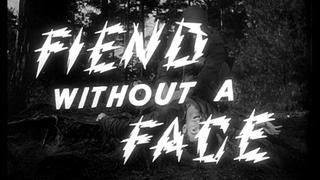
The most interesting thing about the DVD release of Fiend Without A Face is, frankly, the company that released it. The Criterion Collection prides itself on releasing "important classic and contemporary films", and indeed the company pioneered "special edition" releases of the most well regarded films, ranging from Citizen Kane to The Seven Samurai.
Their definition of "important" has been criticized as they released films like The Rock, Armageddon and The Blob, however those films have a cultural importance (and fan-base) that justified their releases. Fiend Without A Face has quite a fan-base as well, collected from decades of television showings and blurry memories of the film's creature. That being said, while Fiend remains an entertaining, above average science fiction creature feature, i'm not quite sure it deserves to be among such luminaries.
Taking place on a Canadian based American Air-base (though actually filmed in England), the film centers on a series of mysterious killings that the locals are blaming on nuclear experiments (dealing with cold war missile control) taking place at the base. Faced with growing unrest, Maj. Jeff Cummings (Marshall Thompson) decides to research the incidents, leading him to Professor Walgate (Kynaston Reeves), a scientist with experience researching telekinetic abilities. After forming a relationship with the scientist's assistant (Kim Parker), Cummings discovers that the bodies of those killed have had their brains and spinal cords removed from their bodies. Christening the attackers as "mental vampires", Cummings discovers that Walgate's experiments have gone out of control, and their power is growing thanks to the nuclear tests.
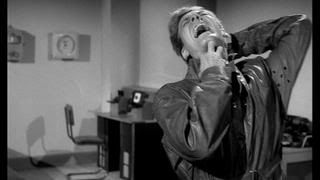
The creatures themselves are truly unforgettable. Disembodied brains with antennae and a wriggling spinal cord behind them must have been an eye-opener for impressionable youth in the 50s, and the stirring, bloody climax of the film was something unheard of at the time. In fact, the film was edited for violence in both England and the United States, and banned outright in several other countries. Compared to films today the violence is certainly tame, but it's not difficult to see why audiences (and reviewers) were disturbed by the content in a pre-Blood Feast world.
The creatures are brought to life through some sub-Harryhausen stop motion effects that still remain effective, though charmingly dated. When shot, the creatures explode with blood and eventually melt gruesomely. However, almost all of these very amusing effects take place in the film's final 15 minutes.
Unfortunately, the creature is mostly what remains worth recommending about the film. The acting ranges from passable (Marshall Thompson in the lead), to laughably bad (Stanley Maxted as Colonel Butler), and the first 50 minutes of this 74 minute film move at a slow pace, the creatures remaining invisible when they attack. The direction by Arthur Crabtree is flat and pedestrian, and while the script (by Herbert J. Leder, director of some notable monster movies himself) throws out some entertaining scientific gobbledygook, the pacing is terminally slow.
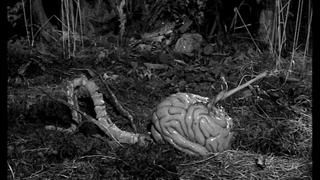
There are also strange inconsistencies in the plot, particularly when it comes to the relationship between Cummings and the professor's assistant. She bitterly chides him for upsetting the professor in one scene, and then makes sympathetic eyes at him in the next. Such plotting errors are to be expected in genre films of the era, but one would hope that a film in the Criterion collection would be a cut above. Unfortunately this is not the case.
While I question the choice of releasing the film in the first place, Criterion (as usual) did a great job with the presentation. The film suffers from print damage in the first ten minutes, but after that the print is clear of significant damage and presented in its original 1.66:1 ratio.
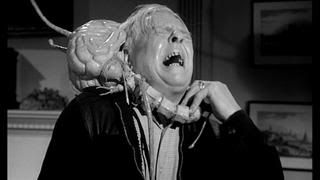
They were also able to come up with some interesting special features, the most significant being a full length commentary (actually a conversation) between author Tom Weaver and executive producer Richard Gordon. The track is candid and genial and features some wonderful information regarding the film's production. I'd go as far to say that the commentary is often more entertaining than the film itself, as Gordon's memory remains sharp and Weaver is a good-natured interviewer.
We're also treated to an illustrated essay on British science fiction and horror film written by Bruce Eder, as well as trailers for The Haunted Stranger, Corridors Of Blood and The Atomic Submarine. Finally, there is a photo gallery with commentary from Gordon, as well as a gallery of vintage newspaper advertisements.
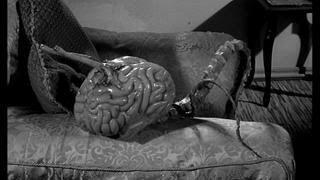
I don't mean to be harsh on what is actually a very memorable b-movie, I just feel that its reputation comes more from the messy, exciting climax (said to have inspired Night Of The Living Dead) then the hour or so that comes before it. Worth seeing, but don't go in expecting a science fiction classic.










3 comments:
It must have been hard not to like a film that had disembodied brains running around.
needs more krang
When I look at that second last image, I keep thinking "Look at me, I'm Davy Crockett!"
Post a Comment